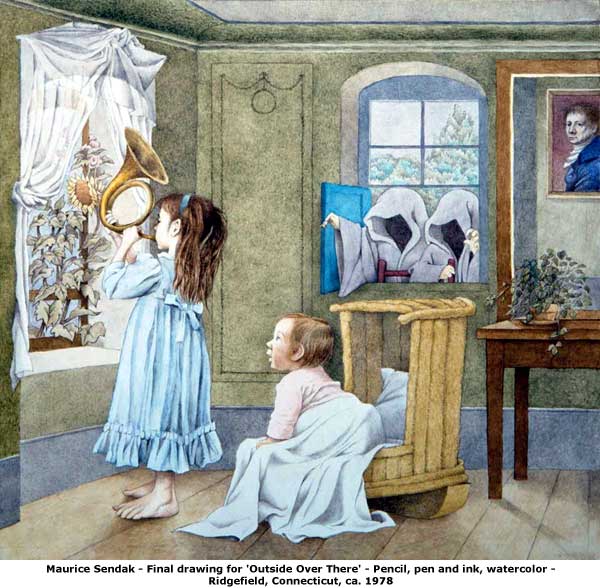Few people know how to tap into a child’s deepest emotional life and shape his or her subconscious forever. Maurice Sendak did. My favorite book of his is Outside Over There, and the reasons why keep changing as I get older. In the Night Kitchen and Where the Wild Things Are seem to explore primal urges and dreams, and are resolved by the characters waking up, or going back to their mommies. I love these books, but in Outside Over There, there’s more at stake.
A baby sister is kidnapped by goblins. The baby is replaced by a changeling made of ice (the scariest thing I could imagine when I was a kid). The mother is absent--waiting for her husband who’s away at sea. Our hero, Ida, probably four or five, has to save her sister using her will, her mother’s cloak, and her wonder horn. The goblins happen to be disguised as babies. Ida entrances them by playing the wonder horn, making them dance so fast that they dissolve into water. Few people could draw this transformation with such naturalism. In the end, Ida is charged with the responsibility of raising her little sister, while her mom stares off to sea, waiting for Ida’s papa to come home. When I was a child, I looked up to Ida. I marveled that a girl could be so brave and save her sister. I longed for one of those big flowing night gowns, and I wanted a sister.
The drawings in this book changed my life. I scrutinized the sunflowers growing up and up and the facial expressions of the portrait in Ida’s room changing slightly. The German Shepherd. The musician and the sailors hidden in the compositions. Sendak’s inspiration seems to have been German and Netherlandish engravers. These drawings don’t take any short cuts. They are very rendered, but carry an emotional weight.
Do I identify more with this book because the main characters are girls? Possibly. The story seems to be more about girls, and what is expected of them. If the protagonist was a boy, would he be expected to raise his younger sibling? Ida has big feet and flowing hair; she's going to be tall and gorgeous. She's more in control of herself than the boys in Where the Wild Things Are and In the Night Kitchen. She has grace.
Now we read this book to my daughter. She’s 2 1/2 and I don’t know how much she gets of it, but she wants to hear it over and over. She thinks the goblins are aliens. Maybe she can just tell how enthusiastic I am about the story. Sendak knows he can take children to these dark places, but he builds in the security of the adult reader guiding them along. This book takes childhood seriously. It talks about love and responsibility and heroism, in a way that is never spelled out. I read somewhere that he revised the book over one hundred times, and it shows. It reads like Yeats, like perfect poetry. I don’t mind reading it over and over again to my daughter, always marveling at new details in the drawings.
